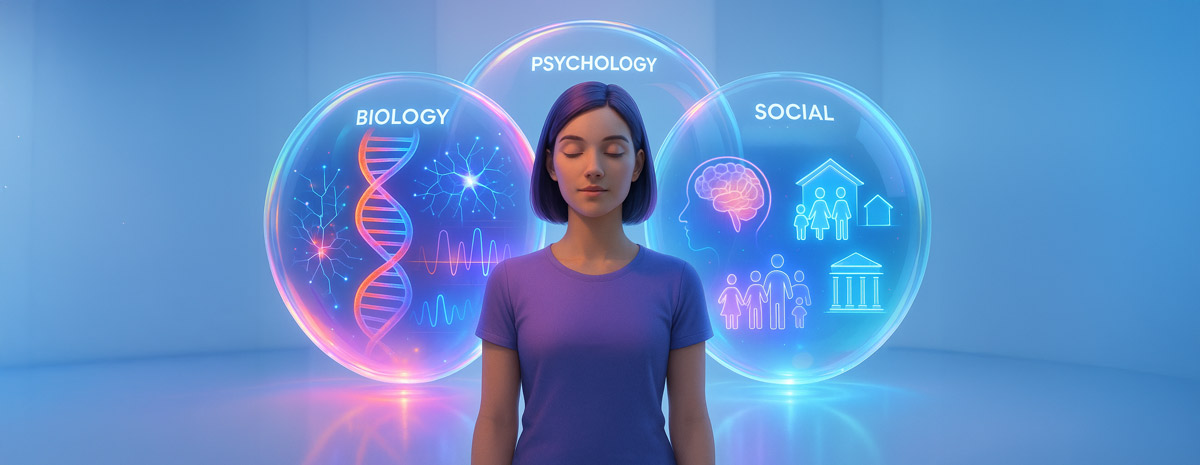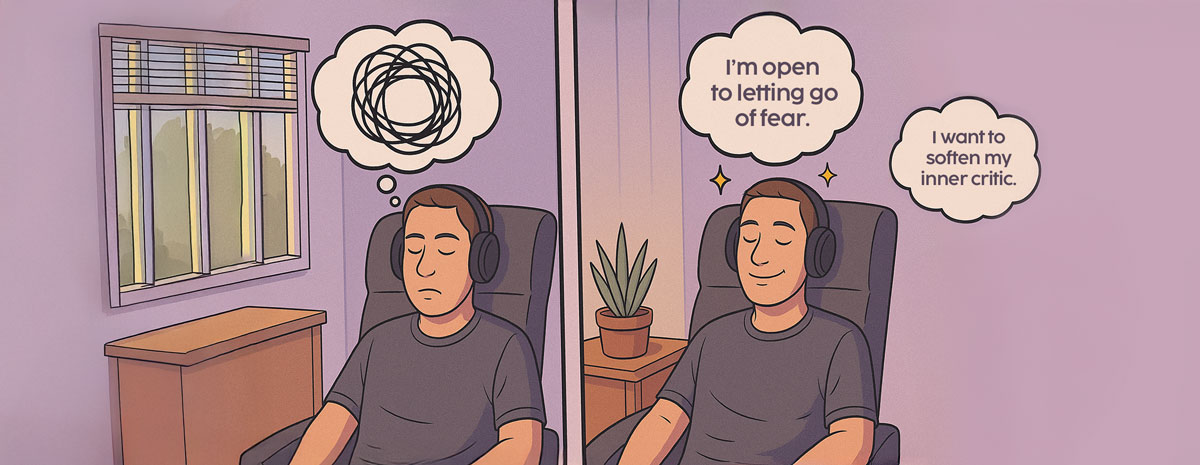Why the Biopsychosocial Model Matters in Ketamine Therapy

Same Protocol, Different Outcomes
You’ve seen it before: Two patients. Same dose. Same schedule. One progresses, the other plateaus. The difference? It's not just chemistry.
This is where the biopsychosocial model becomes essential. Originally introduced by George Engel in 1977, this framework recognizes that health outcomes aren’t shaped by biology alone. Psychological and social factors have just as much influence on healing.
In ketamine therapy, this means that what surrounds the medicine - the mindset, the context, and the support - is just as critical as the molecule itself.
What Is the Biopsychosocial Model?
The biopsychosocial model views healing through three key lenses:
- Biology: Physical and neurochemical effects, like ketamine’s impact on NMDA receptors, neuroplasticity, and inflammation
- Psychology: A patient's thoughts, emotions, beliefs, mindset, and capacity for self-regulation
- Social Context: Environment, relationships, cultural background, financial stress, and daily lived experience
When applied to ketamine therapy, this model encourages a more comprehensive care approach that supports the whole person.
Why Biology Alone Isn’t Enough
Ketamine is fast-acting. But it isn’t magic.
Patients may leave the chair with clarity, openness, or calm - but without proper psychological or social support, these shifts often fade.
Without a biopsychosocial approach:
- Patients return to the same stressors and triggers
- They lack frameworks for processing insight
- Progress stalls or regresses
Research confirms what many providers observe firsthand: it's not just the medicine, it’s what surrounds it that makes the difference.
A 2022 systematic review in Frontiers in Psychology found that outcomes in psychedelic-assisted therapy correlate more strongly with psychological flexibility and social safety than with medication dosage alone.
That means the success of treatment isn’t determined solely by how much ketamine is given, but by the patient’s internal and external environment, and how well it supports their healing. For example, enhancing neuroplasticity during ketamine therapy requires timing, tools, and patient engagement to fully activate the brain’s potential for change.
How the Model Applies to Ketamine Therapy
Here's how each component shows up in real-world clinical practice:
1. Biological Support
- Proper medical screening and protocol design
- Tracking neuroplasticity timelines post-treatment
- Nutritional and sleep support to stabilize the nervous system
2. Psychological Support
- Pre-session mindset priming
- Learn more about how to set the tone early with Intention Setting in Ketamine Therapy.
- Learn more about how to set the tone early with Intention Setting in Ketamine Therapy.
- In-session guidance for emotional regulation
- Structured post-session reflection.
3. Social Support
- Encouraging integration in community or relational settings
- Ensuring follow-up and accessibility of care
- Reducing isolation between sessions
When all three are in place, the brain doesn’t just change. The person does.
How Limitless App Delivers Biopsychosocial Support
Limitless was built around this model from day one. Our tools are designed to engage:
- Biology through nervous system regulation and timed interventions that align with neuroplasticity windows
- Psychology through metacognitive training, guided visualizations, and mindset shifts
- Social context by offering structure patients can use between sessions to stay connected and supported
We support busy clinics with:
- Pre-session priming
- In-session regulation
- Post-session integration
- Daily support to extend care
Want to see how it fits into your workflow? Schedule a discovery call!
Explore Next Steps
Schedule a Discovery Call
See how Limitless can fit into your clinic’s workflow — helping patients engage more deeply in treatment, regulate their nervous systems, and sustain progress between sessions.
How-To: Implementing the Biopsychosocial Model in Your Ketamine Therapy Practice
The biopsychosocial model might sound like a big shift, but it doesn’t require a full systems overhaul to begin applying it.
Many of the most impactful interventions can be implemented today, using tools that align with your existing protocols.
This section offers a step-by-step guide to help ketamine providers integrate the model into real clinical workflows, using Limitless as a framework for scalable support.
Step 1: Pre-Treatment Mindset Priming
Why it matters: What patients bring into the room matters as much as what happens in it. When a patient arrives in a sympathetic state: anxious, uncertain, guarded; their nervous system is in defense mode. This reduces access to insight, reduces neuroplasticity, and increases resistance. This can be a challenging launching pad to go straight into a ketamine induced disassociative state.
What to do: Offer patients brief, focused tools before their appointment. You may start with a brief check in and some breathing exercises to shift into a parasympathetic state.
We designed the first 10+ minutes of each Journey Macrodose, called "Intros" to help patients begin to unwind, anchor to the intention topic in the name of the Journey Macrodose, and shift from where they were before they walked in for treatment, to being present to the ketamine treatment starting now. These tracks help the patient shift into a more receptive state: mentally, emotionally, and physiologically.
Reported Clinical Benefits:
- Reduces pre-treatment anxiety
- Enhances therapeutic alliance
- Improves session readiness
Want to learn more about the role of intention setting in ketamine therapy? Read our full guide here.
Step 2: In-Session Nervous System Regulation
Why it matters: Ketamine activates a neuroplastic window, but if the patient is dysregulated, dissociated, or overwhelmed, that window can close quickly. Emotional overload or confusion during sessions may reduce integration and even lead to dropout.
What to do: Introduce Journey Macrodoses during sessions. These long-form visualizations provide structured, trauma-sensitive support that helps patients navigate the altered state with intention. The tracks are designed to:
- Reduce dissociation and reactivity
- Enhance focus on inner experience
- Maintain parasympathetic balance
These sessions are fully audio-guided, requiring no staff interaction with the device once initiated. This makes them ideal for ketamine, IV, or infusion-based care.
Reported Clinical Benefits:
- Smoother in-session tone
- Fewer mid-session interruptions or distress
- Stronger post-session integration and emotional resilience
Step 3: Post-Treatment Integration Support
Why it matters: The biggest gap in ketamine care is often what happens after the patient leaves. The insights gained during sessions require reflection, repetition, and meaning-making to become part of long-term healing.
Without structured integration, patients may lose momentum or regress, especially in the face of real-world stressors.
What to do: Invite patients to use Limitless’ integration tracks, including Chill Music sessions for downshifting, or guided reflections and journaling prompts inside the app. These tools are short, accessible, and can be used daily or weekly.
Reported Clinical Benefits:
- Higher patient retention
- Reduced post-treatment anxiety
- Greater psychological flexibility
Learn more about the importance of integration here.
Step 4: Practice Daily Mindset Conditioning
Why it matters: Behavior change, and neural rewiring, requires consistency. Daily stressors, emotional habits, and pain cycles can easily reactivate old patterns. Regular mindset training helps patients build emotional agility and develop healthier nervous system baselines over time.
What to do: Encourage use of the Limitless Mindset Microdoses between appointments. These brief daily lessons teach emotional regulation, breathwork, visualization, and reframing techniques in just 15-20 minutes of practice per day.
Reported Clinical Benefits:
- Daily practice increases resilience between sessions
- Improved long-term outcomes
- Greater patient agency in navigating their health
- Patients arrive to treatments with more parasympathetic tone
Frequently Asked Questions About the Biopsychosocial Model in Ketamine Therapy
Explore common questions about applying whole-person care in your practice. Learn how biological, psychological, and social factors influence ketamine outcomes, and how Limitless App helps clinicians implement this model with ease.
In ketamine therapy, biopsychosocial refers to a holistic framework that acknowledges the biological, psychological, and social dimensions of heath.
It recognizes that a patient’s mindset, emotional patterns, and daily life context play just as important a role in their outcome as the dose or protocol.
This model helps explain why two patients with the same treatment plan can respond very differently.
Because ketamine acts on the brain’s most flexible systems, emotion, memory, perception, and identity. Outcomes are shaped by more than the medicine.
The biopsychosocial model emphasizes that patient mindset, environment, and meaning-making processes influence how ketamine is received and integrated.
Without addressing these non-biological factors, the brain often returns to its default patterns, even after a powerful session.
Learn how Limitless is built to support clinicians in our integration guide.
Here are simple ways to integrate the model into your practice:
- Biological: Nutritional support, inflammation reduction, optimizing sleep and neuroplasticity windows.
- Psychological: Guided visualizations, breathwork, intention setting, integration journaling.
- Social: Offering consistent care structures between sessions, encouraging peer/community integration support, addressing relational and systemic stressors.
Limitless delivers tools for all three through our Mindset Companion App for Clinics.
Mindset shapes how patients enter treatment, how they interpret experiences, and how they integrate insights afterward. A hopeful, self-aware mindset supports parasympathetic activation and cognitive flexibility; two key factors in neuroplastic change.
Read the full article on why mindset matters in ketamine therapy.
Yes. Patients in sympathetic overdrive (fight/flight) may struggle to process or retain benefits from ketamine sessions. Tools that guide patients into parasympathetic states, like breath pacing, body scans, or trauma-informed music - help create the internal conditions for sustaining parasympathetic tone.
Mindset training to improve self-regulation skills between ketamine therapy sessions can also build long term resilience and flexibility.
Traditional models often focus on medical delivery: dosing, protocols, and safety. The biopsychosocial model expands this by considering how stress, mindset, trauma history, and environment influence results.
When clinicians use the lens of the Biopsychosocial model to evaluate the whole-person they are treating, it turns ketamine from solely a biochemical intervention into a full-spectrum health experience.
Yes. Every Limitless App session is designed to support biology (via nervous system regulation), psychology (via metacognitive rewiring), and social context (via integration structure and daily practice).
It’s a scalable way to bring biopsychosocial care into every session; without adding staff hours or clinical workflow burdeon.
We recommend starting with our integration article or booking a discovery call.
Final Thoughts
Expand the Frame of Care
If ketamine therapy is evolving, so must our model of delivery. The biopsychosocial model offers a framework for deeper, more sustainable healing.
Patients don’t just need treatment. They need context, connection, and tools.
Biologically active. Psychologically supported. Socially informed.
Schedule a discovery call with our team to bring this model to life in your clinic with Limitless.
How To Integrate Limitless App Into Your Practice
Whether you're exploring mindset support for the first time or ready to roll it out across your treatment rooms, we’ve made it simple to begin. Each kit is designed to help your team introduce Limitless with ease.
Kit
1-Month License
for Patients
for Patients









